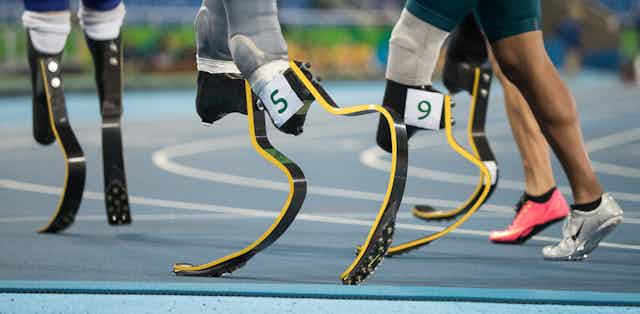As the international significance of Paralympic sport increases, so do the financial rewards and prestige associated with winning Paralympic medals.
As such, it is not surprising that Paralympic classification systems have drawn attention in the lead up to the Rio Games.
Specifically, athletes have publicly expressed concerns that some athletes are in the wrong class.
Additionally, following the Rio Games, UK Athletics is reported to be conducting an internal inquiry into classification processes.
Without classification, para-sport cannot exist
Think about this statement. In order to determine who is a para-athlete and who is not requires a method for differentiating one from the other. In other words, it requires a classification system.
Paralympic classification systems describe the methods used to determine who is eligible for para-sport. The overall aim is to ensure that para-sport is reserved for athletes who have a permanent impairment, such as amputation or weakness/paralysis, that will adversely affect performance in mainstream sport.
Naturally, some athletes have impairments that cause a large adverse impact and others have impairments that are relatively mild. Therefore classification systems perform a second vital function: describing the methods for dividing para-athletes into classes. The aim of this is to ensure that each class comprises athletes who have impairments that cause approximately the same amount of disadvantage in sport.
But some have raised concerns when athletes in the same class performed differently from each other. One athlete might significantly outperform everyone else or, conversely, one athlete might perform at a significantly lower standard than their competitors.
Concerns have also been expressed by previously successful Paralympic athletes who feel they are no longer competitive because they are competing against athletes who are in the wrong class.
Classification problems?
While it is possible that these circumstances could be caused by problems with classification, there are other very plausible and more benign explanations.
Firstly, each Paralympic sport class comprises athletes with impairments that cause approximately the same amount of disadvantage in a sport. Note they’re not exactly the same. Therefore there will always be a bit of a range within a class.
So some of the performance variability within a given class will simply be due to the fact that some athletes have impairments that cause slightly less disadvantage than others in their class.
Within-class variability may also be due to differences in athletic talent and level of training. Just as it is arguable that the reason Usain Bolt is the most successful Olympic sprinter of his generation is because he is more talented than his competitors, it is highly likely that many of the athletes who dominate in Paralympic sport are simply more talented and/or have trained much harder than their competitors, not because they are in the wrong class.
While significant differences in performance are most likely to be due to factors common to most sports, there are possibly two problems particular to classification that are contributing factors.

The complexity of classification
The International Paralympic Committee (IPC) readily acknowledges that classification is “an ongoing and evolving process”. Here are two of the biggest issues currently being addressed.
First is the complexity of assessing the different types of impairments and determining how much each is going to impact on the execution of a given sport.
This complexity means decisions are not always clear-cut, and athletes and coaches can feel they have grounds for dispute. That said, it is critical to note that the methods currently used to classify athletes reflect current best practice. Better methods for placing athletes into para-sports are simply not available.
Classification is conducted by accredited people with recognised medical and/or sports qualifications. These include a medical document review, a detailed history of training and athletic performance and face-to-face evaluation of the athlete’s impairment profile and athletic skill set.
In addition to using current best practice, the IPC has invested in three Postdoctoral Research Fellowships in Paralympic classification. One is at the University of Queensland focusing on classification of physical impairments, one at Vrije University in Amsterdam on vision impairment and one at KU Leuven in Belgium on intellectual impairment.
The Fellowships are improving current systems of classification. For example, by applying principles of body-proportionality to determine prosthetics length in bilateral lower limb amputee runners. They are also using current and emergent technologies to investigate scientifically-based methods for classifying athletes that will enhance the precision of assessments.
Intentional misrepresentation
The second area of classification that concerns athletes stems from the fact that some classification tests are effort-dependent. For example, valid strength measurement requires an athlete to push or pull maximally.
Intentional misrepresentation of abilities is a form of cheating in which an athlete deliberately under-performs on an effort-dependent test with the aim of being allocated to a class for athletes with more severe impairments.
Once again, the procedures currently used by Paralympic sports to detect intentional misrepresentation reflect current best practice. They include observation and measurement of performance data during classification and observation in competition. And if inconsistencies between assessment and competition performance are observed, athletes can be summoned for re-evaluation.
Athletes guilty of intentional misrepresentation can be banned for up to two years. The three Postdoctoral Research Fellowships are actively involved in developing improved methods for detecting intentional misrepresentation in the current system, as well as exploring new methods that can be introduced in the future.
Classification is absolutely integral to Paralympic sport but is inherently complex and not entirely immune to exploitation by dishonest athletes. But the system we have is the best one around, and it keeps getting better, ensuring that the Paralympics is contested on a level playing field.


